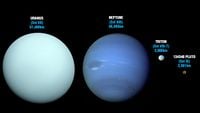Pluto: Difference between revisions
From Halopedia, the Halo wiki
NightHammer (talk | contribs) |
Killamin7i (talk | contribs) m (Nine years later...) |
||
| Line 3: | Line 3: | ||
{{Planet | {{Planet | ||
|name=Pluto | |name=Pluto | ||
|image=[[File:Pluto. | |image=[[File:Pluto-NewHorizons.png|250px]] | ||
|star, position= [[Sol system|Sol]] | |star, position= [[Sol system|Sol]] | ||
|moon(s)= 5 | |moon(s)= 5 | ||
|satellite(s)= | |satellite(s)= | ||
|gravity= 0.067 g | |gravity= 0.067 g | ||
|diameter= {{Convert| | |diameter= {{Convert|2370|km|mi}} | ||
|daylength=6 days 9 hours 17 minutes | |daylength=6 days 9 hours 17 minutes | ||
|yearlength=248.09 years | |yearlength=248.09 years | ||
| Line 28: | Line 28: | ||
Pluto was discovered during 1930, and was then thought to be the ninth and final planet of the Solar System. Its first moon, Charon, was discovered during 1978. During 2005, two smaller moons were discovered. During 2006, arguments began to arise on whether Pluto was actually large enough to be considered a planet. After much debate, Pluto (along with the asteroid Ceres and the object Eris) became newly classified as dwarf planets. | Pluto was discovered during 1930, and was then thought to be the ninth and final planet of the Solar System. Its first moon, Charon, was discovered during 1978. During 2005, two smaller moons were discovered. During 2006, arguments began to arise on whether Pluto was actually large enough to be considered a planet. After much debate, Pluto (along with the asteroid Ceres and the object Eris) became newly classified as dwarf planets. | ||
In 2006, a space probe named ''New Horizons'' was launched to gather more information on Pluto. It | In 2006, a space probe named ''New Horizons'' was launched to gather more information on Pluto. It arrived at the dwarf planet in 2015. It was the first spacecraft to ever visit Pluto. | ||
==Gallery== | ==Gallery== | ||
<gallery> | <gallery> | ||
File:Outerplanets.jpg|Pluto along with Uranus, Neptune and Neptune's moon Triton. | File:Outerplanets.jpg|Pluto along with Uranus, Neptune and Neptune's moon Triton. | ||
File:Pluto.jpg|Artist conception of the dwarf planet. | |||
</gallery> | </gallery> | ||
Revision as of 11:19, July 14, 2015
Template:SeeWikipedia Template:Planet Pluto, formal designation 134340 Pluto, is a dwarf planet in the Sol system, and the second-largest known dwarf planet (after Eris) as well as the tenth-largest body observed directly orbiting Sol. It was named after the Roman God of the Underworld. The Remote Scanning Outpost Democritus is situated in orbit over this dwarf planet. On November 3, 2552, the monitoring station detected Cortana's signal in Slipspace with Dr. Halsey's message to Lord Hood.[1]
As of 2552 there are no human facilities on the dwarf-planet's surface, however several military and scientific stations orbit Pluto.[2] The only known such facility is Kelvin Research Station.[3]
History
Pluto was discovered during 1930, and was then thought to be the ninth and final planet of the Solar System. Its first moon, Charon, was discovered during 1978. During 2005, two smaller moons were discovered. During 2006, arguments began to arise on whether Pluto was actually large enough to be considered a planet. After much debate, Pluto (along with the asteroid Ceres and the object Eris) became newly classified as dwarf planets.
In 2006, a space probe named New Horizons was launched to gather more information on Pluto. It arrived at the dwarf planet in 2015. It was the first spacecraft to ever visit Pluto.
Gallery
- Pluto.jpg
Artist conception of the dwarf planet.
List of appearances
- Halo: Ghosts of Onyx (First appearance)
- Halo Evolutions
- Halo: Hunters in the Dark (Mentioned only)
Sources
- ^ Halo: Ghosts of Onyx, page 212
- ^ Halo Encyclopedia, page 283
- ^ Halo: Evolutions - Essential Tales of the Halo Universe, "The Impossible Life and the Possible Death of Preston J. Cole", page 458
